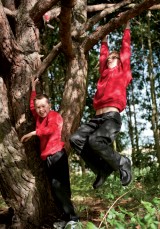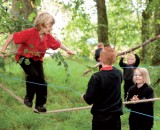Do your local woodlands present limitless opportunities, or are they strictly off limits, asks national charity Learning Through Landscapes?
Outdoors among the trees and shrubs, free from an adult’s gaze, there is a strong sense of freedom that stimulates more imaginative and creative play.There are numerous and ever-changing natural resources which – unlike man-made equipment – are non-prescriptive, their uses only limited by a child’s imagination.
 But while many schools are developing their playgrounds to create natural play spaces, hundreds already have access to a wonderful, but unused, woodland playground right on their doorstep.
But while many schools are developing their playgrounds to create natural play spaces, hundreds already have access to a wonderful, but unused, woodland playground right on their doorstep.
Recognising this untapped resource, six primary schools in Scotland took part in a two-year project to develop the play potential of their woodlands, supported by national charity Learning Through Landscapes (ltl.org.uk) and the Forestry Commission. With a bit of imagination and minimal investment, they reaped considerable rewards.
At Cardross Primary, for instance, the pupil council created a box of resources linked to the woodland, including laminated activities – such as a scavenger hunt – conveniently located at the entrance to the wood, for use by any children playing among the trees. Den building – a simple activity that helps children of all ages develop creativity and problem solving skills – was supported at Lanark Primary with tarpaulins, ropes and mats stored in school and transported to the woodland by trolley. Even Lenzie Moss Primary, which has only a small strip of woodland at the edge of its grass football pitch, was able work together with a ranger from the local nature reserve to develop the area and encourage wildlife.
If your school, like the Scottish primaries, has a patch of woodland crying out to be used for regular play, the following examples will help get your project off the ground.
To reap the benefits of woodland play, keeping adult intervention to a minimum is key. Inevitably, however, clear boundaries regarding acceptable behaviour need to be agreed and engaging children in the process of developing these rules ensures they are widely owned.
Schools that embrace this philosophy recognise that you don’t always need to be able to see children to ensure they are safely supervised. Indeed, maintaining close visual contact in woodland areas can be impossible, as well as unnecessary.
Schools’ solutions
• Invergarry Primary has two acres of mixed woodlands in its grounds. Children play here every break time, navigating rocks, fallen trees and a small stream. With such a large area, it is impossible for staff to keep an eye on all the children all the time, even if it were desirable. Instead, staff stay in one spot so children know where to find them if needed.
• A simple rota system can help you to keep track of who is playing in your woodland. One class per day is allowed in the woods at Chatelherault Primary – and access is monitored using a woodland pass. If a class can’t use their pass for any reason (aclass trip, for example) they hold on to it for the next day.
• Each child at Dalmeny Primary is given a wrist band that has to be handed back if they leave the woods. And because the focus is on quiet, reflective (rather than boisterous) physical play, numbers are limited to small groups of eight or nine.
• At Lanark Primary, where every class has access to the woodland for free play, volunteers from higher up the school – known as Wood Watch Rangers – are enlisted as the eyes and ears of adult supervisors.
 Children naturally seek adventure and challenge, even when it is not provided for directly. Conquering the unknown gives them a buzz, and the desire to do it again. They can test the limits of their physical, intellectual and emotional development, and gain confidence as well as a sense of achievement and the motivation to keep trying.
Children naturally seek adventure and challenge, even when it is not provided for directly. Conquering the unknown gives them a buzz, and the desire to do it again. They can test the limits of their physical, intellectual and emotional development, and gain confidence as well as a sense of achievement and the motivation to keep trying.
In the woodland, play can be open-ended, dynamic and varied. The very fact that it is also at times risky andunpredictable increases the sense of adventure – and the opportunities for learning.
Schools’ solutions
• At Invergarry Primary the children navigate rocks, fallen trees and wet areas with ease, developing their coordination and self-awareness as they swing on low branches, play chase or climb on boulders. In the winter when the burn is frozen, they skate and jump on it until it cracks.
• When Craigdhu Primary installed a board walk to allow access to a particularly wet area of their woodland, they decidednot to add friction strips as they wanted children to learn about the danger of slipping on wood in wet weather.
• Climbing increases upper body strength and improves coordination and balance. It allows the climber to demonstrate persistence and achieve a personal goal. At Cardross Primary, where children are encouraged to risk assess for themselves, trees that are popular for climbing have a ring placed around them indicating the maximum height the children are allowed to reach from the ground.
• Plants provide natural play props and create hidden spaces. Some, however, can pose dangers. While children quickly learn that nettles can sting, some – like fungi – need to be treated with caution. At Invergarry, children have learnt which to avoid with help from a visiting fungi expert.
Most woodland will require little management or maintenance to make it suitable for play and it’s best to keep the spaces as natural as possible. In fact, a better course of action might be to do less and spend the maintenance budget elsewhere.
Firstly, establish who owns the land and make sure you have permission to carry out any changes. Where there is no budget for maintenance but local support is strong, community action days can be arranged to get specific jobs done. Pupilfocused groups can also play an important role – not least in encouraging a sense of ownership.
Schools’ solutions
• The eco-committee at Peel Primary oversees themed assemblies such as ‘caring for ourenvironment’ and a group of pupils known as the Junior Environmental Team (the Jets) act as guardians of the woodland, organising litter picks when needed and phoning the local authority environmental team to report any tree-safety issues.
• At Craigdhu Primary, a planted willow that divides the woodland area from the main playground used to be cut back. Now, to avoid the work involved, it is allowed to grow freely and only coppiced if willow withies are needed within the woodland areas, or for use in an art project.
• Wood felled at Chatelherault Primary has been used by a local artist to create wood carvings – a project funded by the school’s PTA.
• At Dalmeny Primary, children access the woodland – which isn’t part of the school grounds – via an aerial walk way, designed by a parent and built for free by the Royal Engineers. This fun and playful access adds to the children’s excitement and motivation to explore and use the woods.
If you’re interested in finding out more about woodland play then visit the Learning through Landscapes website for a short film and more detailed case studies of the project (ltl.org.uk/woodlandplay). If you’re inspired to consider your own project, LTL has produced a new Woodland Play booklet with practical tips and advice – available for just £3 from their website.
Why every child should feel at home in an art gallery
Ace-Art-And-Design
Help Pupils Tell Fact From Fiction In The Digital World
Ace-Computing
